| Home |
| Acknowledgments |
| Conventions |
| Glossary |
| Maps |
| References |
| Links |
| Articles |
| Thumbnails |
| Species
list |
| Family |
| Next
species |
Additional Photos
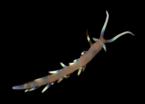
underside

side

Midway form
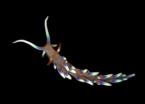
young, 8 mm

on hydroid
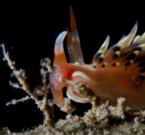
feeding
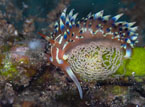
laying eggs

Caloria indica (Bergh, 1896)
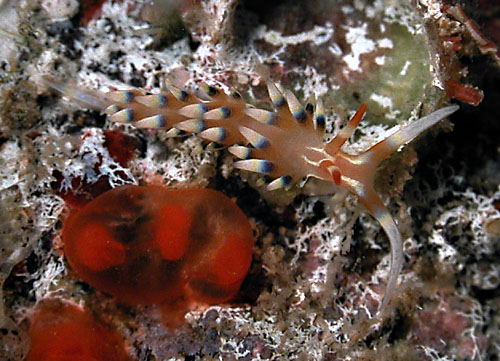
| Maximum size: 35 mm (Kay,
1979). Identification: This species has a translucent-orange body. The cerata have white tips with subapical yellow and cobalt-blue bands. The cephalic tentacles have white tips and there are white lines running from the bases of the cephalic tentacles to the bases of the rhinophores. Behind the rhinophores, the white lines diverge again on the top of the head. The rhinophores have orange tips and white medial bands. Rarely, the bands may be absent. (Note 1) The orange tips on the rhinophores, the divergent white lines behind them and the lack of red lozenges on the sides of the body distinguish the species from Caloria sp. #3. Natural history: Caloria indica is a moderately common species found in moderately exposed to highly exposed rocky habitats at depths of 2-18 m (6-60 ft). It appears to be generally diurnal but we've also seen it actively foraging at night. If feeds on the introduced hydroid Pennaria disticha and lays an irregularly kinked white egg mass. (Note 2) Distribution: Big Island, Maui, Oahu, Kauai, Niihau and Midway: widely distributed in the Indo-Pacific. Taxonomic notes: This is the species listed as Caloria militaris (Alder and Hancock, 1866) in Kay, 1979, Gosliner, 1980 and Bertsch & Johnson, 1981. It's referred to as the "Indian nudibranch" in Hoover, 1998 although the photo is of Flabellina exoptata. It's illustrated in the inset photo under F. exoptata in Hoover, 2006 and corrected in the 5th printing. Some authors list it as Phidiana indica. It was first reported from Hawaii in Baba (1969). It's also listed at Caloria militaris in Kay & Schoenberg-Dole, 1991 (but only the left animal in the photo is this species). There's some chance that Midway animals could be distinct. Photo: PF: Honokohau, Maui; Aug. 5, 1994. Observations and comments: Note 1: Midway animals are brighter and sometimes lack medial white bands on their rhinophores. Note 2: Jenna Szerlag took a sequence of photos showing an animal eating a Pennaria disticha polyp. It appears to be consuming it from the bottom up while letting the ball-like tentacle tips fall away. If this behavior is typical, perhaps it allows the animal to avoid nematocysts concentrated in the tentacle tips? (see photos) |
| Thumbnails |
Species
list |
Family | Next species | Top |